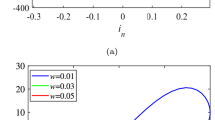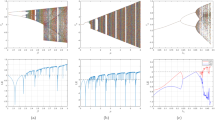Abstract
The fluctuation of ions concentration across the cell membrane of neuron can generate a time varying electromagnetic field. Thus, memristors are used to realize the coupling between the magnetic flux and the membrane potential across the membrane. Such coupling results from the phenomenon of electromagnetic induction in neurons. In this work, we numerically show that the electromagnetic induction phenomenon can firstly suppress chaotic states in a neural setups and secondly enrich neural synchrony in a system of two coupled neurons. By means of the bifurcation diagrams on maximum Lyapunov exponent and interspike interval, we show that increasing in memristor strength delocalizes first, then fully suppresses chaotic states in a single neuron. In a system of two electrically coupled Hindmarsh–Rose-type neurons, we realize that increasing in memristor strength gradually reduces the threshold value of electrical synaptic coupling strength above which a transition to synchronized states is achieved. The transition to synchronized states are determined either by the sign of the maximum transverse Lyapunov exponent or by the magnitude of the synchronization factor. Our results suggest that chaos break in a neurons group by electromagnetic induction phenomenon might automatically release neural synchrony which is involved in information processing and many seizures in the brain.









Similar content being viewed by others
Data Availability Statement
The datasets generated during and/or analyzed during the current study are available from the corresponding author on reasonable request.
References
Chua, L.: Memristor-the missing circuit element. IEEE Trans Circuit Theory 18, 507 (1971)
Strukov, D.B., Snider, G.S., Stewart, D.R., Williams, R.S.: The missing memristor found. Nature 453, 80 (2008)
Sah, M.P., Yang, C., Kim, H., Muthuswamy, B., Jevtic, J., Chua, L.: A Generic Model of Memristors With Parasitic Components. IEEE TCAS I: Regular Papers 62, 891 (2015)
Ben-Abdallah, P.: Thermal memristor and neuromorphic networks for manipulating heat flow. AIP Adv. 7, 065002 (2017)
Ordonez-Miranda, J., Ezzahri, Y., Tiburcio-Moreno, J.A., Joulain, K., Drevillon, J.: Radiative Thermal Memristor. Phys. Rev. Lett. 123, 025901 (2019)
Volos, C.K., Kyprianidis, I.M., Stouboulos, I.N., Vaidyanathan, S.: Memristor: A New Concept in Synchronization of Coupled Neuromorphic Circuits. J Eng Sci Tech Rev 8, 157 (2015)
C.N. Takembo, A. Mvogo, H.P. EkobenaFouda, T.C. Kofané, Effect of electromagnetic radiation on the dynamics of spatiotemporal patterns in memristor-based neuronal network. Nonlinear Dyn. 95 1067 (2019)
Chua, L., Sbitnev, V., Kim, H.: Hodgkin-Huxley axon is made of memristors. Int J Bifurcat Chaos 22, 1230011 (2012)
Hegab, A.M., Salem, N.M., Radwan, A.G., Chua, L.: Neuron Model with Simplified Memristive Ionic Channels. Int J Bifurcat Chaos 25, 1530017 (2015)
Lv, M., Ma, J., Yao, Y., Alzahrani, F.: Synchronization and wave propagation in neuronal network under field coupling. Sci China Tech Sci 62, 448 (2019)
Chen, M., Ren, X., Wu, H., Xu, Q., Bao, B.: Periodically varied initial offset boosting behaviors in a memristive system with cosine memductance. Front Inform Technol Electron Eng 20, 1706 (2019)
Tang, K., Wang, Z., Shi, X.: Electrical Activity in a Time-Delay Four-Variable Neuron Model under Electromagnetic Induction. Front Comput Neurosci 11, 105 (2017)
Etémé, A.S., Tabi, C.B., Mohamadou, A.: Firing and synchronization modes in neural network under magnetic stimulation. Commun Nonlinear Sci Numer Simulat 72, 432 (2019)
Tabi, C.B., Etémé, A.S., Mohamadou, A., Kofané, T.C.: Unstable discrete modes in Hindmarsh-Rose neural networks under magnetic flow effect. Chaos Sol Fract 123, 116 (2019)
Etémé, A.S., Tabi, C.B., Mohamadou, A., Kofané, T.C.: Long-range memory effects in a magnetized Hindmarsh-Rose neural network. Commun Nonlinear Sci Numer Simulat 84, 105208 (2020)
Xu, Y., Jia, Y., Ma, J., Alsaedi, A., Ahma, B.: Synchronization between neurons coupled by memristor. Chaos Sol Fract 104, 435 (2017)
Xu, K., Maidana, J.P., Castro, S., Orio, P.: Synchronization transition in neuronal networks composed of chaotic or non-chaotic oscillators. Sci Rep 8, 8370 (2018)
Rabinovich, M.I., Abarbanel, H.D.I.: The role of chaos in neural systems. Neuroscience 87, 5 (1998)
Dinstein, I., Pierce, K., Eyler, L., Solso, S., Malach, R., Behrmann, M., Courchesne, E.: Disrupted neural synchronization in toddlers with autism. Neuron 70, 1218 (2011)
Hindmarsh, J.L., Rose, R.M.: A model of neuronal bursting using three coupled first order differenial equations. Proc R Soc Lond B 221, 87 (1984)
Yang, F., Gordon, M.P., Urban, J.J.: Theoretical framework of the thermal memristor via a solid-state phase change material. J. Appl. Phys. 125, 025109 (2019)
C. Kass-Petersen, Chaos in Biological System. Plenum, New York, (1987)
Hansel, D., Sompolinsky, H.: Synchronization and Computation in a Chaotic Neural Network. Phys. Rev. Lett. 68, 718 (1992)
Rapp, P.E.: Chaos in the neurosciences: cautionary tales from the frontier. Biologist 40, 89 (1993)
Dhamala, M., Jirsa, V.K., Ding, M.: Transitions to Synchrony in Coupled Bursting Neurons. Phys. Rev. Lett. 92, 028101 (2004)
Dhamala, M., Jirsa, V.K., Ding, M.: Enhancement of Neural Synchrony by Time Delay. Phys. Rev. Lett. 92, 074104 (2004)
Budzinski, R.C., Boaretto, B.R.R., Prado, T.L., Lopes, S.R.: Temperature dependence of phase and spike synchronization of neural networks. Chaos Sol Fract 123, 35 (2019)
Fell, J., Axmacher, N.: The role of phase synchronization in memory processes. Nat Rev Neurosci 12, 105 (2011)
Kantz, H.: A robust method to estimate the maximal Lyapunov exponent of a time series. Phys Lett A 185, 77 (1994)
Yu, W.-T., Tang, J., Ma, J., Yang, X.: Heterogeneous delay-induced asynchrony and resonance in a small-world neuronal network system. EPL 114, 50006 (2016)
Usha, K., Subha, P.A.: Hindmarsh-Rose neuron model with memristors. BioSystems 178, 1 (2019)
Hodgkin, A.L., Huxley, A.F.: A quantitative description of membrane current and its application to conduction and excitation in nerve. J. Physiol. 117, 500 (1952)
Lv, M., Wang, C., Ren, G., Ma, J., Song, X.: Model of electrical activity in a neuron under magnetic flow effect. Nonlinear Dyn 85, 1479 (2016)
Wang, W., Perez, G., Cerdeira, H.A.: Dynamical behavior of the firings in a coupled neuronal system. Phys. Rev. E 47, 2893 (1993)
M.J. Ogorzatek, Chaos and Complexity in Nonlinear Electronic Circuits World, Scientific Publishing Co Pte Ltd, Singapore (1997)
Balcerzak, M., Pikunov, D., Dabrowski, A.: The fastest, simplified method of Lyapunov exponents spectrum estimation for continuous-time dynamical systems. Nonlinear Dyn 94, 3053 (2018)
Zhang, J., Wang, C., Wang, M., Huang, S.: Firing patterns transition induced by system size in coupled Hindmarsh-Rose neural system. Neurocomputing 74, 2961 (2011)
Fehlberg, E.: Classical fifth-, sixth-, seventh-, and eighth-order Runge–Kutta Formulas with stepsize control. Nasa Technical Report 287 (1968)
Nunez, P.L., Srinivasan, R.: Electric Fields of the Brain: The Neurophysics of EEG. Oxford University Press, London (1981)
Izhikevich, E.M.: Neural excitability, spiking and bursting. Int J Bifurcat Chaos 10, 1171 (2000)
Boaretto, B.R.R., Budzinski, R.C., Prado, T.L., Kurths, J., Lopes, S.R.: Neuron dynamics variability and anomalous phase synchronization of neural networks. Chaos 28, 106304 (2018)
Acknowledgements
The corresponding author (A.S. Etémé) is very grateful to all experts who have significantly contributed to the improvement of this paper.
Author information
Authors and Affiliations
Corresponding author
Ethics declarations
Conflict of interest
The authors of this paper declare that they have no conflict of interest concerning the publication of this article.
Additional information
Publisher's Note
Springer Nature remains neutral with regard to jurisdictional claims in published maps and institutional affiliations.
Rights and permissions
About this article
Cite this article
Etémé, A.S., Tabi, C.B., Beyala Ateba, J.F. et al. Chaos break and synchrony enrichment within Hindmarsh–Rose-type memristive neural models. Nonlinear Dyn 105, 785–795 (2021). https://doi.org/10.1007/s11071-021-06640-8
Received:
Accepted:
Published:
Issue Date:
DOI: https://doi.org/10.1007/s11071-021-06640-8




